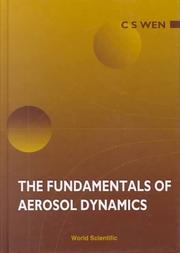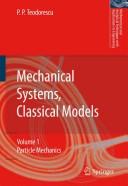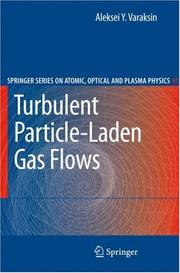| Listing 1 - 10 of 14 | << page >> |
Sort by
|
Book
ISBN: 1527532925 Year: 2019 Publisher: Newcastle upon Tyne, England : Cambridge Scholars Publishing,
Abstract | Keywords | Export | Availability | Bookmark
 Loading...
Loading...Choose an application
- Reference Manager
- EndNote
- RefWorks (Direct export to RefWorks)
Book
ISBN: 9783030886899 Year: 2022 Publisher: Cham Springer International Publishing :Imprint: Springer
Abstract | Keywords | Export | Availability | Bookmark
 Loading...
Loading...Choose an application
- Reference Manager
- EndNote
- RefWorks (Direct export to RefWorks)
Chirality. --- Nanoparticle dynamics. --- Nanoparticles. --- Nano-particles --- NPs (Nanoparticles) --- Nanoscale particles --- Nanostructured materials --- Particles --- Dynamics of nanoparticles --- Nano-particle dynamics --- Nanoparticles --- Particle dynamics --- Stereochemistry --- Symmetry (Physics) --- Enantiomers --- Dynamics

ISBN: 9812796320 9789812796325 9810226616 9789810226619 Year: 1996 Publisher: Singapore ; River Edge, N.J. : World Scientific,
Abstract | Keywords | Export | Availability | Bookmark
 Loading...
Loading...Choose an application
- Reference Manager
- EndNote
- RefWorks (Direct export to RefWorks)
During the past 30 years, there have been advances in the understanding of multi-particle hydrodynamic interactions in the field of aerosol dynamics. Aerosol dynamics is developing from isolated-particle stage into multi-particle stage. This book reviews these progresses, and the subjects it covers include sedimentation, coagulation, mass or heat transfer, effective viscosity, and the evolution of the size distribution.
Aerosols. --- Particle dynamics. --- Colloids --- Gases --- Dynamics of a particle --- Dynamics of particles --- Particles --- Dynamics --- Dynamics of a particle.
Book
ISBN: 1421427648 1421429411 Year: 2004 Publisher: Johns Hopkins University Press
Abstract | Keywords | Export | Availability | Bookmark
 Loading...
Loading...Choose an application
- Reference Manager
- EndNote
- RefWorks (Direct export to RefWorks)
As unique sources of coherent high-power, microwave, and millimeter-wave radiation, gyrotrons are an essential part of the hunt for controlled fusion. Presently, gyrotrons are actively used for electron cyclotron resonance plasma heating and current drive in various controlled fusion reactors. These sources have been under development in many countries for more than forty years. In spite of their widespread use, however, there is as yet no single book to introduce non-specialists to this vital field.Now Gregory S. Nusinovich, an early pioneer of the gyrotron and widely regarded today as the world's leading authority on the subject, explains the fundamental physical principles upon which gyrotrons and related devices operate. Nusinovich first sets forth some "rules of thumb" that allow readers to understand gyrotron operation in simple terms. He then explores the fundamentals of the general theory of gyrotrons and offers an overview of the various types of gyro-devices, including gyromonotrons, gyroklystrons, gyro-traveling-wave tubes, and gyrotwystrons. He explains not only the theory, linear and nonlinear, but also the practical challenges that users of such devices face. This book will be of interest to undergraduate and graduate students as well as to those who develop gyrotrons or who use them in various applications. It should also appeal to plasma physicists interested in charged-particle dynamics, as well as to applied physicists needing to know more about micro- and millimeter-wave technologies.
Dynamics of a particle. --- Plasma radiation. --- Gyrotrons. --- Particle dynamics. --- Cyclotron resonance masers --- Microwave tubes --- Bremsstrahlung --- Cyclotron resonance --- High temperature plasmas --- Radiation --- Dynamics of a particle --- Dynamics of particles --- Particles --- Dynamics --- Wave mechanics (vibration & acoustics)

ISBN: 1280937815 9786610937813 1402054424 1402054416 9048173698 Year: 2007 Publisher: Dordrecht : Springer,
Abstract | Keywords | Export | Availability | Bookmark
 Loading...
Loading...Choose an application
- Reference Manager
- EndNote
- RefWorks (Direct export to RefWorks)
All phenomena in nature are characterized by motion; this is an essential property of matter, having infinitely many aspects. Motion can be mechanical, physical, chemical or biological, leading to various sciences of nature, mechanics being one of them. Mechanics deals with the objective laws of mechanical motion of bodies, the simplest form of motion. In the study of a science of nature mathematics plays an important role. Mechanics is the first science of nature which was expressed in terms of mathematics by considering various mathematical models, associated to phenomena of the surrounding nature. Thus, its development was influenced by the use of a strong mathematical tool; on the other hand, we must observe that mechanics also influenced the introduction and the development of many mathematical notions. In this respect, the guideline of the present book is precisely the mathematical model of mechanics. A special accent is put on the solving methodology as well as on the mathematical tools used; vectors, tensors and notions of field theory. Continuous and discontinuous phenomena, various mechanical magnitudes are presented in a unitary form by means of the theory of distributions. Some appendices give the book an autonomy with respect to other works, special previous mathematical knowledge being not necessary. Some applications connected to important phenomena of nature are presented, and this also gives one the possibility to solve problems of interest from the technical, engineering point of view. In this form, the book becomes – we dare say – a unique outline of the literature in the field; the author wishes to present the most important aspects connected with the study of mechanical systems, mechanics being regarded as a science of nature, as well as its links to other sciences of nature. Implications in technical sciences are not neglected. Audience: Librarians, and researchers interested in the fundamentals of mechanics.
Dynamics of a particle --- Mechanics --- Mathematical models. --- Classical mechanics --- Newtonian mechanics --- Physics --- Dynamics --- Quantum theory --- Particle, Dynamics of a --- Mechanics. --- Mathematics. --- Mathematical physics. --- Classical Mechanics. --- Applications of Mathematics. --- Mathematical Methods in Physics. --- Physical mathematics --- Math --- Science --- Mathematics --- Applied mathematics. --- Engineering mathematics. --- Physics. --- Natural philosophy --- Philosophy, Natural --- Physical sciences --- Engineering --- Engineering analysis --- Mathematical analysis

ISBN: 1280951494 9786610951499 3540680543 3540680535 3642087728 Year: 2007 Publisher: Berlin ; New York : Springer,
Abstract | Keywords | Export | Availability | Bookmark
 Loading...
Loading...Choose an application
- Reference Manager
- EndNote
- RefWorks (Direct export to RefWorks)
Results are given of experimental and theoretical studies of "gas-solid particles" turbulent two-phase flows. Special emphasis is placed on studies of the behavior of particles suspended in a turbulent gas flow and their feedback effect on the characteristics of flow of the carrier phase. The characteristics of heterogeneous flows in channels (pipes) are analyzed, as well as those in the vicinity of the critical points of bodies subjected to flow and in the boundary layer developing on their surface. Problems of physical simulation of turbulent gas flows which carry solid particles are treated in detail. This monograph will be useful for researchers involved in investigations of gas dynamics and heat and mass transfer in multiphase flows, as well as for university professors, post-graduate students, and students.
Gas flow. --- Two-phase flow. --- Dynamics of a particle. --- Particle, Dynamics of a --- Flow, Two-phase --- Fluid dynamics --- Multiphase flow --- Flow of gas --- Gases, Flow of --- Aerodynamics --- Gas dynamics --- Air flow --- Engineering. --- Fluid- and Aerodynamics. --- Engineering, general. --- Construction --- Industrial arts --- Technology --- Fluids. --- Hydraulics --- Mechanics --- Physics --- Hydrostatics --- Permeability
Book
ISBN: 128263819X 0262265877 9780262265874 9780262266239 0262266237 0262013894 9780262013895 0262265583 9781282638198 Year: 2010 Publisher: Cambridge, Mass. MIT Press
Abstract | Keywords | Export | Availability | Bookmark
 Loading...
Loading...Choose an application
- Reference Manager
- EndNote
- RefWorks (Direct export to RefWorks)
A novel algorithmic approach to mechanism design based on a geometric representation of kinematic function called configuration space partitions. "This book presents the configuration space method for computer-aided design of mechanisms with changing part contacts. Configuration space is a complete and compact geometric representation of part motions and part interactions that supports the core mechanism design tasks of analysis, synthesis, and tolerancing. It is the first general algorithmic treatment of the kinematics of higher pairs with changing contacts. It will help designers detect and correct design flaws and unexpected kinematic behaviors, as demonstrated in the book's four case studies taken from industry. After presenting the configuration space framework and algorithms for mechanism kinematics, the authors describe algorithms for kinematic analysis, tolerancing, and synthesis based on configuration spaces. The case studies follow, illustrating the application of the configuration space method to the analysis and design of automotive, micro-mechanical, and optical mechanisms. Appendixes offer a catalog of higher-pair mechanisms and a description of HIPAIR, an open source C++ mechanical design system that implements some of the configuration space methods described in the book, including configuration space visualization and kinematic simulation. HIPAIR comes with an interactive graphical user interface and many sample mechanism input files. The Configuration Space Method for Kinematic Design of Mechanisms will be a valuable resource for students, researchers, and engineers in mechanical engineering, computer science, and robotics."
Machinery, Kinematics of. --- Computer-aided design. --- Configuration space. --- Machine design. --- Machinery --- Space, Configuration --- CAD (Computer-aided design) --- Computer-assisted design --- Kinematics of machinery --- Design --- Design and construction --- Engineering design --- Configurations --- Dynamics of a particle --- Wave functions --- Computer-aided engineering --- Machinery, Dynamics of --- Mechanical movements --- COMPUTER SCIENCE/General --- Particle dynamics
Book
ISBN: 9400736835 9048127637 9786612459894 1282459899 9048127645 Year: 2009 Publisher: New York ; Dordrecht : Springer Science + Business Media,
Abstract | Keywords | Export | Availability | Bookmark
 Loading...
Loading...Choose an application
- Reference Manager
- EndNote
- RefWorks (Direct export to RefWorks)
This third volume completes the Work Mechanical Systems, Classical Models. The first two volumes dealt with particle dynamics and with discrete and continuous mechanical systems. The present volume studies analytical mechanics. Topics like Lagrangian and Hamiltonian mechanics, the Hamilton-Jacobi method, and a study of systems with separate variables are thoroughly discussed. Also included are variational principles and canonical transformations, integral invariants and exterior differential calculus, and particular attention is given to non-holonomic mechanical systems. The author explains in detail all important aspects of the science of mechanics, regarded as a natural science, and shows how they are useful in understanding important natural phenomena and solving problems of interest in applied and engineering sciences. Professor Teodorescu has spent more than fifty years as a Professor of Mechanics at the University of Bucharest and this book relies on the extensive literature on the subject as well as the author's original contributions. Audience: scientists and researchers in applied mathematics, physics and engineering.
Dynamics of a particle -- Mathematical models. --- Mechanics -- Mathematical models. --- Applied Mathematics --- Applied Physics --- Engineering & Applied Sciences --- Mechanics --- Dynamics of a particle --- Mathematical models. --- Particle, Dynamics of a --- Classical mechanics --- Newtonian mechanics --- Physics. --- Applied mathematics. --- Engineering mathematics. --- Mechanics. --- Mathematical Methods in Physics. --- Applications of Mathematics. --- Physics --- Dynamics --- Quantum theory --- Mathematical physics. --- Mathematics. --- Classical Mechanics. --- Math --- Science --- Physical mathematics --- Mathematics --- Engineering --- Engineering analysis --- Mathematical analysis --- Natural philosophy --- Philosophy, Natural --- Physical sciences
Book
ISBN: 3319341642 3319341669 Year: 2016 Publisher: Cham : Springer International Publishing : Imprint: Springer,
Abstract | Keywords | Export | Availability | Bookmark
 Loading...
Loading...Choose an application
- Reference Manager
- EndNote
- RefWorks (Direct export to RefWorks)
This book describes a promising approach to problems in the foundations of quantum mechanics, including the measurement problem. The dynamics of ensembles on configuration space is shown here to be a valuable tool for unifying the formalisms of classical and quantum mechanics, for deriving and extending the latter in various ways, and for addressing the quantum measurement problem. A description of physical systems by means of ensembles on configuration space can be introduced at a very fundamental level: the basic building blocks are a configuration space, probabilities, and Hamiltonian equations of motion for the probabilities. The formalism can describe both classical and quantum systems, and their thermodynamics, with the main difference being the choice of ensemble Hamiltonian. Furthermore, there is a natural way of introducing ensemble Hamiltonians that describe the evolution of hybrid systems; i.e., interacting systems that have distinct classical and quantum sectors, allowing for consistent descriptions of quantum systems interacting with classical measurement devices and quantum matter fields interacting gravitationally with a classical spacetime.
Physics. --- Mathematical physics. --- Quantum physics. --- Statistical physics. --- Dynamical systems. --- Quantum Physics. --- Mathematical Physics. --- Statistical Physics, Dynamical Systems and Complexity. --- Configuration space. --- Space, Configuration --- Configurations --- Dynamics of a particle --- Wave functions --- Quantum theory. --- Complex Systems. --- Statistical Physics and Dynamical Systems. --- Physics --- Mathematical statistics --- Quantum dynamics --- Quantum mechanics --- Quantum physics --- Mechanics --- Thermodynamics --- Statistical methods --- Particle dynamics --- Dynamical systems --- Kinetics --- Mathematics --- Mechanics, Analytic --- Force and energy --- Statics --- Physical mathematics
Book
ISBN: 1402089872 9048180449 1402089880 Year: 2008 Publisher: Dordrecht : Springer,
Abstract | Keywords | Export | Availability | Bookmark
 Loading...
Loading...Choose an application
- Reference Manager
- EndNote
- RefWorks (Direct export to RefWorks)
This second volume of Mechanical Systems, Classical Models, deals with the dynamics of systems consisting of discrete particles as well as continuous systems. While differences between these models are highlighted, the generality of the proofs and corresponding computations yields results that are expressed in a common form for both discrete and continuous systems. The author explains in detail all important aspects of the science of mechanics, regarded as a natural science, and shows how they are useful in understanding important natural phenomena and solving problems of interest in applied and engineering sciences. A large variety of problems are analyzed, from the traditional to more recent ones, such as the dynamics of rigid solids with variable mass. Professor Teodorescu has spent more that fifty years as a Professor of Mechanics at the University of Bucharest and this book relies on the extensive literature on the subject as well as the author's original contributions. Audience: students and researchers in applied mathematics, physics, chemistry, mechanical engineering.
Dynamics of a particle -- Mathematical models. --- Mechanics -- Mathematical models. --- Mechanics. --- Applied Physics --- Applied Mathematics --- Engineering & Applied Sciences --- Dynamics of a particle --- Mechanics --- Particle, Dynamics of a --- Classical mechanics --- Newtonian mechanics --- Mathematical models. --- Physics. --- Applied mathematics. --- Engineering mathematics. --- Mathematical Methods in Physics. --- Applications of Mathematics. --- Physics --- Dynamics --- Quantum theory --- Mathematical physics. --- Mathematics. --- Classical Mechanics. --- Math --- Science --- Physical mathematics --- Mathematics --- Engineering --- Engineering analysis --- Mathematical analysis --- Natural philosophy --- Philosophy, Natural --- Physical sciences
| Listing 1 - 10 of 14 | << page >> |
Sort by
|

 Search
Search Feedback
Feedback About UniCat
About UniCat  Help
Help News
News